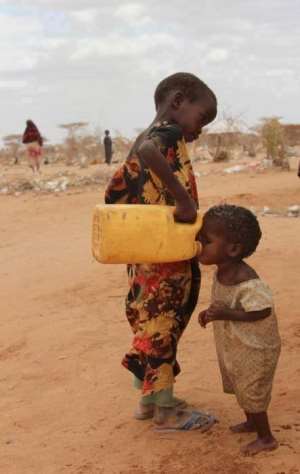
It is terribly sad that lots of children under five are still dying of pneumonia, diarrhoea and malaria in Ghana (although we have been able to reduce under-five mortality from 108 per 1000 live births in 1998 to 82 per 1000 live births in 2012) (See Ghanaweb/The Public Agenda 7th March 2014). While our ability of hitting the target of the Millennium Development Goal 4 (MDG 4 – Reducing child mortality by two-thirds by 2015) is unclear, what is clear is that we can do better than what we are currently doing, in terms of saving the lives of our children.
It is, however, refreshing to know that the government through the Ministry of Health and other stakeholders are working assiduously to get the situation under control, through the Integrated Community Case Management (ICCM) – an initiative which was introduced in the year 2000 with the aim of increasing access to treatment for residents in areas deficient in health facilities. As part of this initiative, some individuals receive tuition for six months and graduate as Community Health Workers (CHW) and treat those diseases in their localities.
Nevertheless, we seem to be moving round in circles. Indeed the programme is helpful, but the fact that our children are still dying is a testimony to the fact that we cannot depend exclusively on such a strategy. We have been organising that programme for people for that purpose since the inception of the initiative and we are still doing that. Are we serious? It is Greek to me that we keep doing something which cannot help us achieve the desired results, time and again. We simply refuse to learn!
To be able to hit the target of MDG 4, or at least, prevent our children below the age of 5 from dying, we need to go beyond what we are currently doing. To develop a health policy which is more effective, Ghana has to embrace an integrated health policy development that will encompass children and mothers. In other words, we should adhere to promoting and implementing a policy that will focus on children and their mothers.
The CHW activities should include the education of mothers. They should be educated on the causes of those three diseases. This will go a long way to prevent them. This is better than the current arrangement of waiting for children to be attacked before the CHW are called into action, leading to numerous deaths; in some cases, the victim (patient) even die before the CHW start working to salvage the situation.
Moreover, we can save our children from those diseases by making sure their mothers are active or “fit” first. Empirical evidence (based on research conducted by researchers from Cambridge and Southampton Universities in the United Kingdom) points to a positive correlation between a mother's “fitness” and that of her child. Thus, a child of an active mother is likely to be active; a “dull” mother is likely to have a “dull” child. It is extensively acknowledged that exercise helps immensely in making people fit – preventing diseases,regardless of age.
Hence, it is imperative that mothers are motivated to exercise in order to be active and healthy. Inasmuch as there is that positive correlation, the children of such mothers are likely to be free from those three diseases. I am not sure about the ability of a month old child (in terms of exercise), but I am sure of that of a two-year old. The CHW should, as a matter of urgency, be equipped with the requisite expertise needed to educate mothers to exercise regularly in the full glare of their children.
In a nutshell, to succeed in making significant inroads into curbing the death of children below the age of 5 (regardless of whether we can hit the target of MDG 4 or not), we should implement a cost-effective health policy which incorporates the education of mothers – on the causes of those three diseases and the need for them to be active – into what already obtains in the country. This, I believe, will reduce the onslaught of those diseases, which means the work load of the CHW (in fighting those diseases) will reduce. A reduction in their work load means more resources for the country. Such resources can be channelled into other sectors for development.




 We’ll protect state wealth from opaque deals – Prof Jane Naana
We’ll protect state wealth from opaque deals – Prof Jane Naana
 Mauritania president says running for second term in June polls
Mauritania president says running for second term in June polls
 I won't ever say I was a mere driver’s mate' — Prof. Opoku-Agyemang
I won't ever say I was a mere driver’s mate' — Prof. Opoku-Agyemang
 2024 polls: 'EC struggling to defend credibility'— Prof. Opoku-Agyemang
2024 polls: 'EC struggling to defend credibility'— Prof. Opoku-Agyemang
 Akufo-Addo gov't's 'greed, unbridled arrogance, unrestrained impunity, sheer dis...
Akufo-Addo gov't's 'greed, unbridled arrogance, unrestrained impunity, sheer dis...
 Election 2024: Ghana needs an urgent reset, a leadership that is inspiring – Ma...
Election 2024: Ghana needs an urgent reset, a leadership that is inspiring – Ma...
 Partner NDC to rollout a future of limitless prospects – Prof Jane Naana Opoku-A...
Partner NDC to rollout a future of limitless prospects – Prof Jane Naana Opoku-A...
 NPP will remain in gov’t till Jesus comes — Diana Asamoah
NPP will remain in gov’t till Jesus comes — Diana Asamoah
 Sunyani Technical University demands apology from former SRC president over sex-...
Sunyani Technical University demands apology from former SRC president over sex-...
 'Dumsor' was resolved by Mahama but ‘incompetent' Akufo-Addo has destroyed the g...
'Dumsor' was resolved by Mahama but ‘incompetent' Akufo-Addo has destroyed the g...
